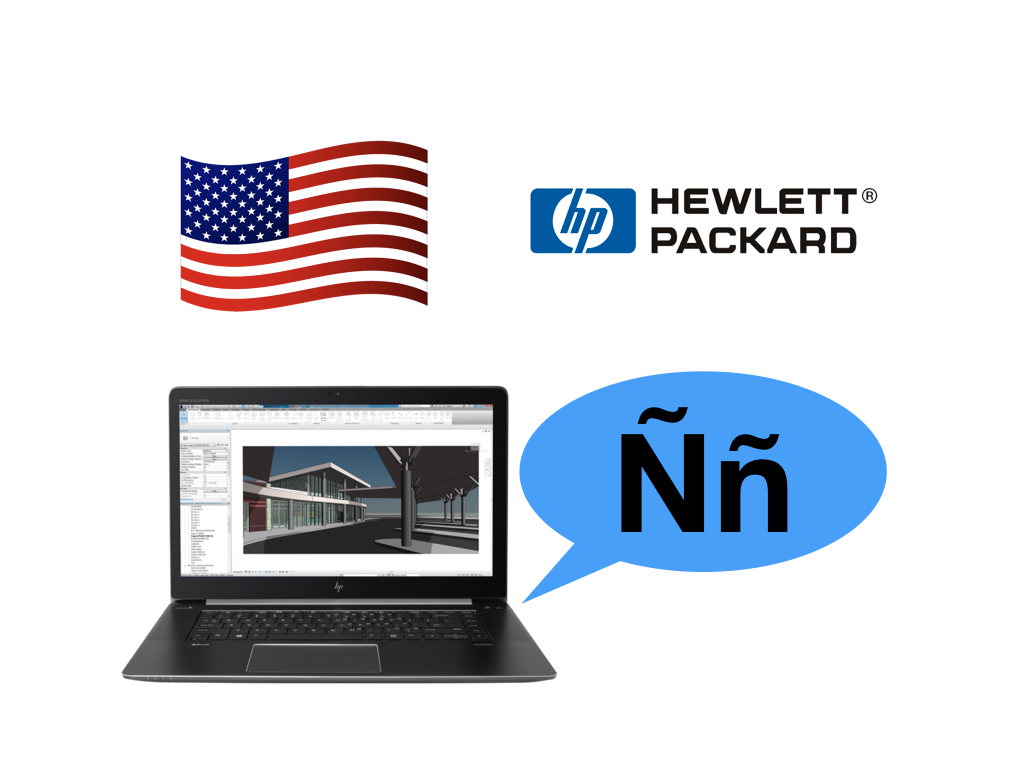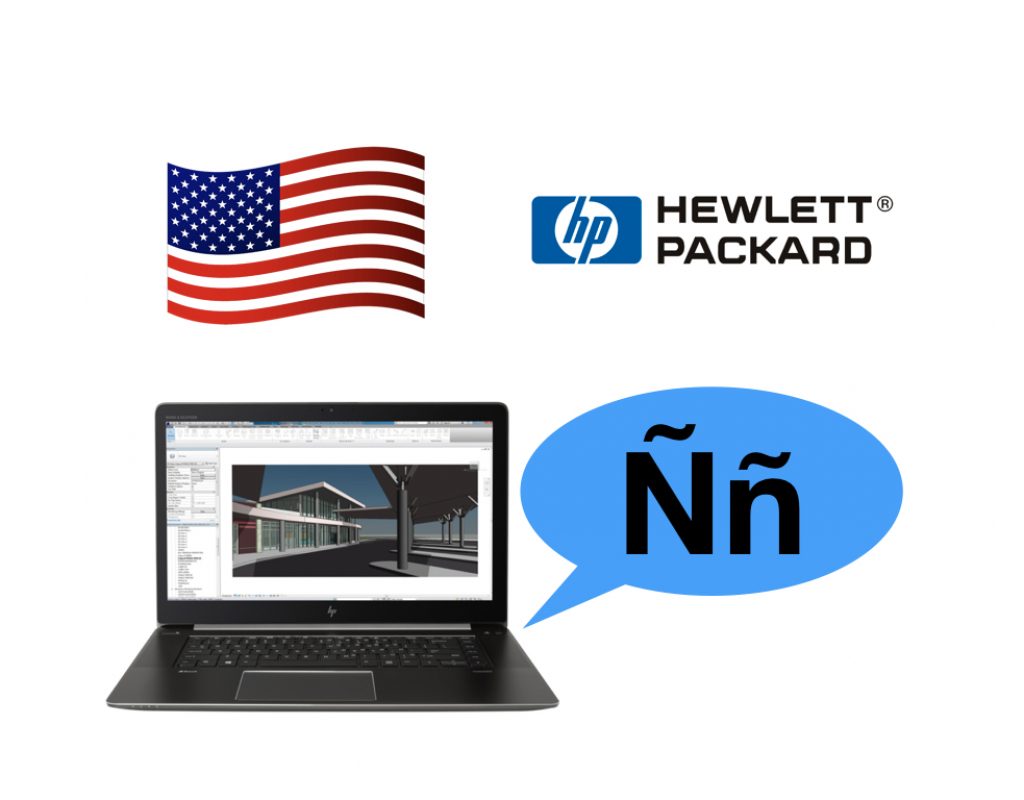
I am delighted to inform you that HP (United States) has finally reversed its previous totalitarian policy of only offering its ZBook Studio workstation with a very limiting US keyboard. Now, purchasers of the ZBook Studio workstation (an excellent choice for demanding professional video editors and some color graders) in the United States fortunately have a keyboard choice when configuring the ZBook Studio G4 online during purchase. Unlike the ZBook Studio G3 that HP sent me in 2016 for review, now in 2017, they sent me the G4 with the superior Spanish European ISO keyboard and built-in matte DreamColor display. Beyond the fact that the United States is the second largest Castilian-speaking country in the world, the much more complete European ISO Spanish keyboard layout is ideal even for English-only writers, for all of the reasons I describe ahead. I am so happy that HP (US) has recognized this fact, as Apple did many years ago. Before now, the European ISO Spanish HP keyboard version was available exclusively via HP Spain, not from HP US or even from HP Latin America.
The built-in European ISO Spanish keyboard in the ZBook Studio G4
Above is the European ISO Spanish keyboard in the ZBook Studio G4 that HP sent me for review. The layout matches the one in my MacBook Air, and in any other Apple Spanish ISO keyboards that Apple has sold within the past decade, anywhere in the world.
Benefits of using the European ISO Spanish keyboard even if you only type in English
- Absolutely nothing is missing from the European ISO Spanish keyboard to type in English.
- If desired, you may retain your menus and dialogs in English. In all modern operating systems, the keyboard setting is fortunately independent from the language of the user interface setting. This includes operating systems like ChromeOS, iOS, Linux, macOS and Windows.
- All of the letters are in the exact same position as in the standard US keyboard. Only a few of the symbols change a bit in position.
- You are able to type names with accent marks, the ñ/Ñ letter, and other diacritical marks directly, without having to search for strange and difficult to remember key combinations. Even if you type only in English, it is important to be able to type people’s names like José or Verónica, countries like México and Perú properly, as well as terms like piña colada, the French-derived résumé, and brands that use accent marks even in the US like Bacardí, Nescafé and Nestlé.
- With the Spanish ISO keyboard you have direct access to the most widely used currency symbols like € for the euro and $ for both pesos (used in Argentina, Chile, Colombia, Cuba, Dominican Republic, México, Philippines and Uruguay) and dollars (used in Antigua and Barbuda, Australia, Bahamas, Barbados, Belize, Bermuda, Brunei, Canada, Cayman Islands, Dominica, East Timor, Ecuador, El Salvador, Fiji, Grenada, Guyana, Hong Kong, Jamaica, Kiribati, Marshall Islands, Federated States of Micronesia, Namibia, Nauru, New Zealand and its territories, Palau, Puerto Rico, Saint Kitts and Nevis, Saint Lucia, Saint Vincent and the Grenadines, Singapore, Solomon Islands, Suriname, Taiwan, Trinidad and Tobago, Tuvalu, United States and its territories and Zimbabwe).
- The European Spanish ISO keyboard is the only one to cover the most languages that use an alphabet derived from the Latin (aka Roman) alphabet, including Castilian, Catalán, English, Euskera (Basque), French, Galician, German, Irish (Gaeilge, aka Gaelic or Irish Gaelic), Italian, Scots, Portuguese, Valencian and Welsh. The European Spanish ISO keyboard is the most international one available, and requires about a 60-second explanation for anyone who already touch-types on the US keyboard. On the other hand, with a French keyboard, it’s impossible to type in Castilian.
Some reasons why the European ISO Spanish keyboard crushes the inferior Latin American keyboard layout
The following irrefutable differences have nothing to do with patriotism. I am not a Spaniard nor a Latin American. I am just a US-born and raised bilingual person who has compared the two, and noticed the enormous differences:
- The horrible Latin American keyboard lacks the € symbol, while the superior European ISO Spanish keyboard includes both the € and $ symbol, with all of the advantages mentioned in the prior section.
- The inferior Latin American keyboard layout has the @ symbol in a non-standard position compared to the US or European Spanish ISO keyboard. The Latin American keyboard unfortunately has the @ symbol on the letter Q, rather than the number 2, which is the standard position in both the US and European ISO Spanish layout.
- The Latin American keyboard layout is even machista, since the Latin American keyboard lacks the symbol required to type feminine ordinal numbers in Castilian (but does offer the one for masculine ordinal numbers), both of which are present on the European Spanish ISO keyboard.
- The position of the standard Castilian accent mark is located in an uncomfortable location on the Latin American keyboard (next to the P key) which requires frequent lifting of the pinky, which is much more stressful on the hand. Fortunately, the European ISO Spanish keyboard layout has the standard Castilian accent mark in the center row, just to the right of the Ñ key.
Standby for my full review of the ZBook Studio G4
Please standby for my full review of the ZBook Studio G4 with inboard matte DreamColor display. I am holding off until HP and NVDIA can (hopefully) resolve an issue with non-integer framerates like 23.976, 29.97, 47.952 and 59.94. Remember that although exact 24 is standard for certain distributions, exact 30 and exact 60 hasn’t been used for television since before 1953, when the United States added color to the monochromatic system and changed the framerate to approximately 29.97. This meant that the (then interlaced-only) field rate went from 60 to approximately 59.94. Since that change occurred in 1953, it’s about time that companies like Apple, HP and NVDIA recognize the new rates. A small percentage of video productions in the US (and most of the Americas) use exact 24, exact 25 and exact 50. Most video (non-DCI, non-digital cinema) in the US use 23.976, 29.97 and 59.94. Exact 24 is mainly for DCI, and 25 and 50 are mainly for distribution in PAL and ex-PAL regions, which in the Americas, only represent Argentina, Paraguay and Uruguay. All of those three countries are PAL-N broadcast countries. Brazil’s unique PAL-M uses the same 23.976, 29.97 or 59.94 rate as NTSC.
In the meantime, I am delighted that HP now offers the ZBook Studio G4 with European (ISO) Spanish keyboard in the US, and that the display is matte in any version, except when someone requests a touch version.
If you need to order a ZBook Studio G4 before my review comes out, the place to do so is at this link to the HP (US) online store.
Among many other customization options, you’ll see this one to select the superior European ISO Spanish backlit keyboard (labeled simply as “Spanish” there), which is also spill-resistant, although I don’t plan to test that particular feature. It’s always better to avoid spilling on your keyboard.
If you want an external European ISO Spanish keyboard in the US, consider this one from Logitech, which is solar, wireless and currently costs under US$20.
Upcoming articles, reviews, radio shows, books and seminars/webinars
Stand by for upcoming articles, reviews, and books. Sign up to my free mailing list by clicking here. Most of my current books are at books.AllanTepper.com, and my personal website is AllanTepper.com.
Si deseas suscribirte a mi lista en castellano, visita aquí. Si prefieres, puedes suscribirte a ambas listas (castellano e inglés).
Listen to his CapicúaFM show at CapicúaFM.com in iTunes or Stitcher.
FTC disclosure
No manufacturer is specifically paying Allan Tépper or TecnoTur LLC to write this article or the mentioned books. Some of the other manufacturers listed above have contracted Tépper and/or TecnoTur LLC to carry out consulting and/or translations/localizations/transcreations. Many of the manufacturers listed above have sent Allan Tépper review units, including HP, but so far, none from Bacardí, Nescafé or Nestlé. So far, none of the manufacturers listed above is/are sponsors of the TecnoTur programs, although they are welcome to do so, and some are, may be (or may have been) sponsors of ProVideo Coalition magazine. Some links to third parties listed in this article and/or on this web page may indirectly benefit TecnoTur LLC via affiliate programs. Allan Tépper’s opinions are his own.
Copyright and use of this article
The articles contained in the TecnoTur channel in ProVideo Coalition magazine are copyright Allan Tépper/TecnoTur LLC, except where otherwise attributed. Unauthorized use is prohibited without prior approval, except for short quotes which link back to this page, which are encouraged!

